Tammar wallaby
The tammar wallaby (Macropus eugenii), also known as the dama wallaby or darma wallaby,[2] is a small macropod native to South and Western Australia. Though its geographical range has been severely reduced since European colonization, the tammar remains common within its reduced range and is listed as "Least Concern" by the International Union for Conservation of Nature (IUCN). It has been introduced to New Zealand and reintroduced to some areas of Australia where it had been previously eradicated. Skull differences distinguish tammars from Western Australia, Kangaroo Island, and mainland South Australia, making them distinct population groups or possibly different subspecies.
| Tammar wallaby | |
|---|---|
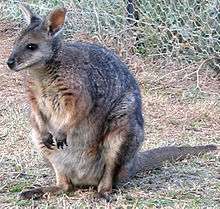 | |
| Scientific classification | |
| Kingdom: | Animalia |
| Phylum: | Chordata |
| Class: | Mammalia |
| Infraclass: | Marsupialia |
| Order: | Diprotodontia |
| Family: | Macropodidae |
| Genus: | Macropus |
| Species: | M. eugenii |
| Binomial name | |
| Macropus eugenii Desmarest, 1817 | |
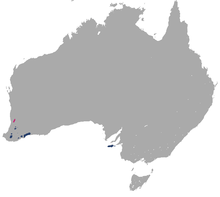 | |
| Current tammar wallaby range. Red areas are where they have been reintroduced. | |
The tammar is among the smallest of the wallabies in the genus Macropus. Its coat color is largely grey. The tammar has several notable adaptations, including the ability to retain energy while hopping, color vision, and the ability to drink seawater. A nocturnal species, it spends nighttime in grassland habitat and daytime in shrubland. It is also very gregarious and has a seasonal, promiscuous mating pattern. A female tammar can nurse a joey in her pouch while keeping an embryo in her uterus. The tammar is a model species for research on marsupials, and on mammals in general. It is one of many organisms to have had its genome sequenced.
Taxonomy and classification
The tammar wallaby was seen in the Houtman Abrolhos off Western Australia by survivors of the 1628 Batavia shipwreck, and recorded by François Pelsaert in his 1629 Ongeluckige Voyagie.[3]:53 It was first described in 1817 by the French naturalist Anselme Gaëtan Desmarest, who gave it the name eugenii based on where it was found; an island he knew as Ile Eugene in the Nuyts Archipelago off South Australia, which is now known as St. Peter Island. The island's French name was given in honour of Eugene Hamelin, commander of the ship Naturaliste;[4]:333 whose name is now the specific name of the tammar. The common name of the animal is derived from the thickets of the shrub locally known as tamma (Allocasuarina campestris) that sheltered it in Western Australia.[5]
| |||||||||||||||||||||||||||||||||||||||||||||||||||||||||||||||||||||||||||||||||
| Phylogeny from Dodt et al. (2017). This clarifies the relationship between the three subgenera of Macropus, Macropus (sensu stricto), Osphranter, and Notamacropus, and the group now includes the genus Wallabia.[6] |
The tammar is classified together with the kangaroos, wallaroos and several species of wallaby in the genus Macropus, and in the subgenus Notamacropus with the other wallabies, all of which have a facial stripe.[7]
Fossil evidence of the tammar wallaby exists from the Late Pleistocene Era—remains were found in the Naracoorte Caves.[7] The mainland and island-dwelling tammars split from each other 7,000–15,000 years ago,[4]:332 while the South Australian and Western Australian animals diverged around 50,000 years ago. The tammar wallabies on Flinders Island had greyer coats and thinner heads than the Kangaroo Island tammars, which are larger than the East and West Wallabi Islands animals. The island tammars were once thought to be a separate species from the mainland population.[4]:333
A 1991 examination of tammar skulls from different parts of the species' range found that the populations can be divided into three distinct groups: one group made of the populations from mainland Western Australia, East and West Wallabi Islands, Garden Island and Middle Island; a second group comprising the populations from Flinders Island, 19th-century mainland Southern Australia and New Zealand; and a third group consisting solely of the Kangaroo Island population.[8] The Western Australia Department of Environment and Conservation listed these populations as the subspecies M. e. derbianus, M. e. eugenii and M. e. decrees, respectively.[5]
Characteristics
One of the smallest wallaby species in the genus Macropus, the tammar wallaby features a small head and large ears with a long tail, thick at the base.[9] It has dark grey-brown upperparts with paler grey highlights, rufous on the sides of the body and limbs, particularly in males, and pale grey-buff underparts.[5] The tammar wallaby exhibits significant sexual dimorphism, with the maximum recorded weight in males being 9.1 kg (20 lb) and maximum recorded weight in females is 6.9 kg (15 lb). The body length is 59 to 68 cm (23–27 in) in males and 52 to 63 cm (20–25 in) in females. Both males and females are about 45 cm (18 in) in height. The tails of males range from 34 to 45 cm (13–18 in) and those of females from 33 to 44 cm (13–17 in).[9]
Locomotion
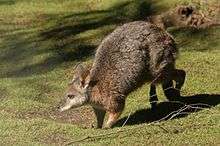
As with most macropods, the tammar wallaby moves around by hopping. This species has a hopping frequency of 3.5 strides per second, with a stride length of 0.8 to 2.4 m (2.6–7.9 ft).[10] When hopping, proximal muscles at the knee and hip joints generate most of the power for each leap, which are delivered by multi-joint muscles at the ankle.[11] As it lands, the energy of the jump is converted into strain energy made when its leg tendons are stretched. As it leaps back off the ground, the tammar can recover much of this energy for reuse though elastic recoil.[12]
The amount of energy stored in the tendons increases with the animal's speed and the weight of the load it is carrying. This is particularly helpful for mothers carrying young,[13] and explains why tammars can increase their hopping speed without using more energy.[14] The tammar shares this characteristic with other plains-dwelling macropods like the red kangaroo. By comparison, rock wallabies, such as the yellow-footed rock-wallaby, have traded efficient energy-saving for greater tendon thickness; an adaption for steep rocky terrain as it allows them to leap higher and lowers the risk of their tendons rupturing.[15]
Senses
The tammar has 324° peripheral vision and 50° binocular vision.[4]:312 It can distinguish black/white gratings of different widths and in different light conditions better than most other small mammals, such as rabbits. It is nevertheless not as good as a cat or a human.[16] Tammars appear to have some colour vision: its eyes have only blue sensitive and green sensitive photoreceptor cones, allowing it to see colour in the blue-green band of the colour spectrum, but not the longer wavelengths of the red-yellow band. Nevertheless, in the band where it can see colour, it can differentiate between two monochromatic colours with wavelengths as close as 20 nm (2.0×10−8 m) apart.[17] The pinna (ear) of the tammar is mobile, allowing it to track sounds from different parts of its surroundings without moving its head. A tammar can point its pinna at a sound source and increase its eardrum's sound pressure by 25–30 dB at 5 kHz. When the pinna moves away from the sound source, the animal's hearing level quickly drops.[18] When born, a tammar's sense of smell is already developed; this allows the newborn to find its mother's pouch by the scent.[19]
Thermoregulation and water turnover
Tammars lick their forearms and pant to keep cool in hot weather. They breathe more heavily and lose more water when the temperature is over 30 °C (86 °F). Tammars can't survive in temperatures above 40 °C (104 °F) and must find cooler surroundings.[20] To prevent dehydration, tammars urinate less and reabsorb water from the distal colon, which gives them relatively dry feces. Being able to concentrate more urine in their kidneys allows them to survive on seawater.[21]
Sudden deaths
In late 1998, 120–130 tammar wallabies died suddenly in research facilities and zoos in New South Wales and Queensland, perishing less than twelve hours after exhibiting the first symptoms, with most exhibiting no symptoms at all. Post mortem examination revealed haemorrhage of muscle, and abdominal and thoracic organs. The syndrome is known as tammar sudden death syndrome and the pathogen is an orbivirus of the family Reoviridae.[22] It does not occur south of Sydney. Captive populations of tammar wallabies in New South Wales have subsequently suffered infections in summer months.[23] No treatment has been attempted due to the rapid progression of the disease.[24]
Ecology and life history
Mostly nocturnal, tammar wallabies spend much of their time foraging.[4]:335 In winter their home ranges are about 16 ha (40 acres), but in the dry summers they range further afield to search for quality food, needing about 42 ha (100 acres) of space. Tammar home ranges overlap with those of conspecifics.
During the day, tammars stay close to scrub for shade and move out to more open grassland by nightfall.[4]:335 Like all macropods, the tammar is herbivorous. They are known to both graze and browse, but the latter is less effective, as they commonly drop leaves when chewing on them. When eating large leaves, tammars handle them with their forelimbs.[25]:116 This species spends more time chewing its food than other similar sized macropods, which likely aids digestion.[25]:115–16 Tammars commonly feed on acacia seeds. Other species consumed include heart-leaved poison (Gastrolobium bilobum), small-flowered wallaby grass (Austrodanthonia setacea), and marri (Corymbia calophylla).[5] Tammars survive on several islands that have no fresh water, subsisting on seawater and the moisture in plants.[4]:335

The tammar rests in two positions: a "sitting tail forward" position, in which the hind legs are outstretched with tail brought forward in between, the body prone and the head above ground; and a "lying" position, in which the animal lies on its side with the head touching the ground. The former position is typically used during the day for long periods, and the latter position is used at night for brief periods.[25]:217–19 Tammars are known to live in stable groups,[26] which lessens the chance of an individual being taken by a predator. As the group increases in size, tammars spend more time foraging, grooming and interacting and less time being vigilant and moving around.[27] Predators of the tammar include dingos, feral cats, red foxes, spot-bellied eagle-owls and wedge-tailed eagles. They may also have been preyed upon by the extinct thylacine. Tammars appear to respond more to the sight than the sound of predators.[28] They can also use their acute sense of smell to detect a predator.[29] When a predator is detected, a tammar will alert others by thumping its foot.[28] When lost, young tammars are known to emit a coarse screeching call and adult females may respond with a similar call.[26]
Breeding and development
The tammar wallaby has a promiscuous mating system.[30] It is a seasonal breeder and births largely occur during late January and early February.[31]:77 During the breeding season, the male's prostate and bulbourethral gland enlarge. However, there does not appear to be any seasonal difference in the weight of the testes.[32] Around two weeks before the first births, the males will begin sniffing the urogenital openings and pouches of the females to determine their reproductive status.[31]:78 After giving birth, females enter estrus and allow males to mate with them. However, a male that attempts to mate with an estrous female may face aggression from other males.[30] A male can achieve reproductive success by mate-guarding. During the estrous period, males establish a dominance hierarchy and the higher ranking males will try to prevent subordinates from mating with estrous females.[31]:83 Several males may pursue a single female.[30]

The female tammar can conceive shortly after giving birth.[4]:335 Tammars undergo embryonic diapause and the blastocyst remains dormant for nearly a year.[33] For the first half of the year, the presence of the joey in the pouch prevents the blastocyst from developing and experiments have shown that removing the joey within this first half will stimulate the blastocyst's development. However, after this, the blastocyst remains dormant even after the joey has left. It begins to develop by the summer solstice at the end of December and the female gives birth around one month later.[34] After birth the newborn young climbs unaided by its mother from the birth canal to the pouch.[35]
When it reaches the pouch, the underdeveloped joey suckles the teat of one of the four mammary glands while the others recede. The joey remains attached to the teat for 100–125 days, after which it ceases its attachment but remains in the pouch and continues to suckle, but more intermittently. The joey begins to leave the pouch and eat grass at around 200 days when it is more developed. It still suckles, more forcefully but less regularly. By 250 days, the joey no longer needs the pouch, and it is fully weaned at around 300–350 days.[36] The tammar wallaby has been observed to engage in alloparental care, in which an adult may adopt another's young.[37] Male tammars may live for around 11 years, while females live for 14 years.[5]
Population dynamics and conservation

The tammar wallaby is listed as Least Concern by the IUCN, because of its abundance and presumably stable population.[1] However, the fragmentation of its range has led to high amounts of inbreeding and morphological abnormalities in some populations.[38]
Since European occupation, tammar wallaby populations on both mainland Australia and some of the islands have been greatly reduced or even eradicated. In the early 20th century, the mainland population of tammars in Western Australia was described as numerous in much of the southwest, but declining in the cultivated areas, particularly to the north.[39] Clearings made for wheat and sheep caused the population to decline further.[4]:332 From the 19th century, tammars in the Eyre Peninsula and around Adelaide were decimated by mobs of hunters organised to protect crops and pastures. As a result, they were extinct in the areas around Adelaide by the 1920s, and in the Eyre Peninsula around the 1970s.[4]:332–33 Tammars from Flinders Island and St Peter Island were eradicated in a similar manner.[4]:333
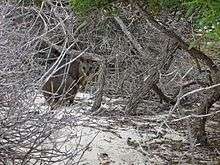
Tammars from these areas were introduced to Kawau Island in New Zealand by colonial administrator Sir George Grey in 1870.[40] They were introduced to the Rotorua area in the early 20th century. Since then, they have flourished to the point where their foraging has damaged indigenous plants. Pest control operators have used sodium fluoroacetate, a naturally occurring rodenticide, to control their populations,[41] a practice which has been controversial because of its possible effect on organisms not targeted, including humans. Cyanide pellets have been used as an alternative.[42] In 1985, tammars were introduced to the North Island of the Houtman Abrolhos and have made similar impacts on native vegetation. Their numbers grew to 450 individuals, but by 2008 culling efforts appeared to have reduced their numbers to 25 individuals.[43]:82–83 In 2003, the Monarto Zoo temporarily housed 85 tammars from New Zealand awaiting reintroduction to the Innes National Park on the Yorke Peninsula in South Australia.[44] Four releases have been made, and a stable wild population of 100–120 animals exists as of 2012.[45] Tammars have also been successfully translocated to other areas, such as Nambung National Park and Avon Valley National Park in Western Australia.[1]
Resistance to sodium fluoroacetate
Different tammar populations have varying levels of resistance to sodium fluoroacetate. Mainland Western tammars appear to be the most resistant, while those on Kangaroo Island are much more vulnerable.[46] Tammars from New Zealand are also vulnerable, as the poison has been successfully used to control their populations.[4]:334 Tammars from East and West Wallabi Islands and Garden Island, which do not have plants containing sodium fluoroacetate, are less resistant than mainland Western tammars but are more resistant than those from Kangaroo Island.[46] This suggests that tammars originated in South Australia and developed a resistance to sodium fluoroacetate when they reached Western Australia, where the poison is found in plants.[4]:334
Use in science
Model organism
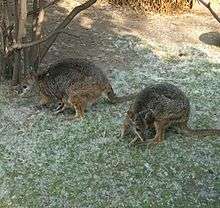
The tammar wallaby is a model organism for studying marsupial biology, as well as mammal biology in general. It has been used in the fields of reproductive biology, immunology, metabolism, neurobiology and many others. Its "seasonal and lactational control of its reproduction" make its reproduction particularly suited for study.[33] Tammars are inexpensive to keep in captivity and are easy to handle.[47] They also breed well, especially if there is at least one male for five females. Tammars used for scientific study are generally housed in outdoor pens with access to water and shelter, which is closer to their natural habitat than a laboratory.[33][48]
The genomes of marsupials are of great interest to scientists studying comparative genomics, and the study of tammars has provided much information about the genetics of marsupials and mammals in general. Marsupials are at a convenient degree of evolutionary divergence from humans; mice are too close and have not developed many different functions, while birds are genetically too remote.[49] Key immune genes from the tammar wallaby were isolated and studied in 2009,[47] and the full genome was sequenced in 2011 and the researchers found "innovation in reproductive and lactational genes, rapid evolution of germ cell genes, and incomplete, locus-specific X inactivation". The researchers also found new HOX genes that control gene expression, as well as novel microRNAs. The tammar genome appears to have more rearrangements than those of both the human and the gray short-tailed opossum, another sequenced marsupial.[50]
Potential pharmaceutical use
A compound in the milk of the tammar wallaby called AGG01 has the potential to be a new and powerful antibiotic. AGG01 is a protein, and in laboratory tests has proven to be 100 times more effective than penicillin. It has killed over 99% of the pathogenic bacteria (both Gram-positive and Gram-negative) that it was incubated with, including Salmonella, Proteus vulgaris and Staphylococcus aureus. It also killed one species of fungus.[51] Subsequent analysis of the genome has led to the discovery of several cathelicidin peptides, which could also be used as antibiotics.[52]
Gut microbiota related with greenhouse effect
The foregut of the tammar wallaby contains species of bacteria belonging to the phyla Firmicutes, Bacteroidetes and Proteobacteria. Within the phylum Proteobacteria, species of the family Succinivibrionaceae are the most abundant and a new species named WG–1 was discovered. WG–1 is a capnophilic bacterium. This has important environmental implications as the bacteria produces less methane than others and does not require CO2 to survive. Research suggests that this information could be used to reduce carbon production in livestock.[53]
References
- Morris, K.; Friend, T.; Burbidge, A; van Weenen, J. (2008). "Macropus eugenii". IUCN Red List of Threatened Species. 2008. Retrieved 1 December 2014.
- Simons, John (2013). Kangaroo. London: Reaktion Books. p. 30. ISBN 978-1-86189-922-4.
members of this subspecies are also known as darma or dama Wallabies
- Pearson, M. (2005). Great Southern Land: The maritime exploration of Terra Australis (PDF). Department of the Environment and Heritage, Government of Australia. ISBN 978-0-642-55185-6. Archived from the original (PDF) on 31 July 2008. Retrieved 21 December 2007.
- Tyndale-Biscoe, Hugh (2005). Life of Marsupials. CSIRO Publishing. ISBN 978-0-643-06257-3.
- "Tammar Wallaby". Western Australia Department of Environment and Conservation. Archived from the original on 25 February 2011. Retrieved 12 June 2011.
- Dodt, W. G.; Gallus, S.; Phillips, M. J.; Nilsson, M. A. (2017). "Resolving kangaroo phylogeny and overcoming retrotransposon ascertainment bias". Scientific Reports. 7 (1): 16811. doi:10.1038/s41598-017-16148-0. PMC 5711953. PMID 29196678.
- Dawson, L.; Flannery, T. (1985). "Taxonomic and Phylogenetic Status of Living and Fossil Kangaroos and Wallabies of the Genus Macropus Shaw (Macropodidae: Marsupialia), with a New Subgeneric Name for the Larger Wallabies". Australian Journal of Zoology. 33 (4): 473–98. doi:10.1071/ZO9850473.
- Poole, W. E.; Wood, J.T.; Simms, N.G. (1991). "Distribution of the Tammar and relationships of populations as determined by cranial morphometrics". Wildlife Research. 18 (5): 625–39. doi:10.1071/WR9910625.
- Labiano-Abello, A. M. "Macropus eugenii Tammar wallaby". Animal Diversity Web, University of Michigan. Retrieved 12 June 2011.
- Baudinette, R.V.; Gannon, B. J.; Runciman, W.B.; Wells, S.; Love, J. B. (1987). "Do cardiorespiratory frequencies show entrainment with hopping in the tammar wallaby?" (PDF). Journal of Experimental Biology. 129 (1): 251–63. PMID 3585241.
- McGowan, C. P.; Baudinette, R.V.; Biewener, A. A. (2005). "Joint work and power associated with acceleration and deceleration in tammar wallabies (Macropus eugenii)". Journal of Experimental Biology. 208 (1): 41–53. doi:10.1242/jeb.01305. PMID 15601876.
- Biewener, A. A.; Baudinette, R. V. (1995). "In vivo muscle force and elastic energy storage during steady-speed hopping of tammar wallabies (Macropus eugenii)" (PDF). Journal of Experimental Biology. 198 (9): 1829–41. PMID 9319738.
- Baudinette, R. V.; Biewener, A. A. (1998). "Young wallabies get a free ride". Nature. 296 (6703): 653–54. Bibcode:1998Natur.395..653B. doi:10.1038/27111.
- Baudinette, R. V.; Snyder, G. K.; Frappell, P. B. (1992). "Energetic cost of locomotion in the tammar wallaby". American Journal of Physiology. 262 (5 Pt 2): R771–8. doi:10.1152/ajpregu.1992.262.5.R771. PMID 1590472.
- McGowan, C. P.; Baudinette, R. V.; Biewener, A. A. (2008). "Differential design for hopping in two species of wallabies". Comparative Biochemistry and Physiology A. 150 (2): 151–58. doi:10.1016/j.cbpa.2006.06.018. PMID 16861021.
- Hemmi, J. M.; Mark, R. F. (1998). "Visual acuity, contrast sensitivity and retinal magnification in a marsupial, the tammar wallaby (Macropus eugenii)". Journal of Comparative Physiology A. 183 (3): 379–87. doi:10.1007/s003590050264. PMID 9763704.
- Hemmi, J. M. (1999). "Dichromatic colour vision in an Australian marsupial, the tammar wallaby". Journal of Comparative Physiology A. 185 (6): 509–15. doi:10.1007/s003590050411.
- Coles, R. B.; Guppy, A. (1986). "Biophysical Aspects of Directional Hearing in the Tammar Wallaby, Macropus eugenii" (PDF). Journal of Experimental Biology. 121 (1): 371–94.
- Schneider, N. Y.; Fletcher, T. P.; Shaw, G.; Renfree, M. B. (2009). "The olfactory system of the tammar wallaby is developed at birth and directs the neonate to its mother's pouch odours". Reproduction. 138 (5): 849–57. doi:10.1530/REP-09-0145. PMID 19638443.
- Dawson, T. J.; Denny, M. J. S.; Hulbert, A. J. (1969). "Thermal balance of the macropodid marsupial Macropus eugenii (Desmarest)". Comparative Biochemistry and Physiology. 31 (4): 645–53. doi:10.1016/0010-406X(69)90065-6. PMID 5367360.
- Hum, I. D.; Dunning, A. (1979). "Nitrogen and electrolyte balance in the wallabies Thylogale thetis and Macropus eugenii when given saline drinking water". Comparative Biochemistry and Physiology A. 63 (1): 135–39. doi:10.1016/0300-9629(79)90639-X.
- "Tammar Wallaby Sudden Death Syndrome (TSDS) Fact Sheet" (PDF). Australian Wildlife Health Network. 22 February 2012. Archived from the original (PDF) on 20 March 2012. Retrieved 18 June 2012.
- Kirkland, P. D. (2005). "Epidemic Viral Diseases in Wildlife". Microbiology Australia. 26 (2): 82–85. ISSN 1324-4272.
- Vogelnest, L; Portas T (2008). Medicine of Australian Mammals. CSIRO Publishing. p. 181. ISBN 978-0643091504.
- Lentle, R. G. (1998). Feeding strategies of the tammar wallaby (Macropus eugenii Desmarest) (Ph.D. thesis). Massey University.
- Russell, E. M. (1984). "Social behaviour and social organization of marsupials". Mammal Review. 14 (3): 101–54. doi:10.1111/j.1365-2907.1984.tb00343.x.
- Blumstein, D. T.; Evans, C. S.; Daniel, J. C. (1999). "An experimental study of behavioural group size effects in tammar wallabies, Macropus eugenii". Animal Behaviour. 58 (2): 351–60. CiteSeerX 10.1.1.131.3641. doi:10.1006/anbe.1999.1156. ISSN 0003-3472. PMID 10458887.
- Blumstein, D. T.; Daniel, J. C.; Griffin, A. S.; Evans, C. S. (2000). "Insular tammar wallabies (Macropus eugenii) respond to visual but not acoustic cues from predators". Behavioral Ecology. 11 (5): 528–35. doi:10.1093/beheco/11.5.528.
- Murchison, E. P.; Adams, D. J. (2011). "Sequencing skippy: the genome sequence of an Australian kangaroo, Macropus eugenii". Genome Biology. 12 (8): R81. doi:10.1186/gb-2011-12-8-123. PMC 3245606. PMID 21861852.
- Rudd, C. D. (1994). "Sexual behaviour of male and female tammar wallabies (Macropus eugenii) at post-partum oestrus". Journal of Zoology. 232 (1): 151–62. doi:10.1111/j.1469-7998.1994.tb01565.x.
- Miller, E. J.; Eldridge, M. D. B.; Herbert, C. A. (2010). "Dominance and paternity in the tammar wallaby". In Coulson, G.; Eldridge, M. (eds.). Macropods: The Biology of Kangaroos, Wallabies and Rat-Kangaroos. CSIRO Publishing. pp. 77–85. ISBN 978-0-643-09662-2.
- Inns, R. W. (1982). "Seasonal changes in the accessory reproductive system and plasma testosterone levels of the male tammar wallaby, Macropus eugenii, in the wild". Journal of Reproduction and Fertility. 66 (2): 675–80. doi:10.1530/jrf.0.0660675. PMID 7175821.
- Hickford, D.; Frankenberg, S.; Renfree, M. B. (2009). "The Tammar Wallaby, Macropus eugenii: A Model Kangaroo for the Study of Developmental and Reproductive Biology". Cold Spring Harbor Protocols. 4 (12): 1–12. doi:10.1101/pdb.emo137.
- Renfree, M. B.; Tyndale-Biscoe, C. H. (1973). "Intrauterine development after diapause in the marsupial Macropus eugenii". Developmental Biology. 32 (1): 28–40. doi:10.1016/0012-1606(73)90217-0. PMID 4791592.
- Renfree M. B.; Fletcher T. P.; Blanden D. R.; Lewis P. R.; Shaw G.; Gordon K.; Short R. V.; Parer-Cook E.; Parer D. (1989). "Physiological and Behavioral Events around the Time of Birth in Macropodid Marsupials". In Grigg G.; Jarman P.; Hume, I. D. (eds.). Kangaroos, Wallabies and Rat-Kangaroos. Surrey Beatty & Sons Pty. Ltd. pp. 323–27. ISBN 978-0949324207.
- Trott, J. F.; Simpson, K. J.; Moyle, R. L. C.; Hearn, C. M.; Shaw, G.; Nicholas, K. R.; Renfree, M. B. (2003). "Maternal regulation of milk composition, milk production, and pouch young development during lactation in the tammar wallaby (Macropus eugenii )". Biology of Reproduction. 68 (3): 929–36. doi:10.1095/biolreprod.102.005934. PMID 12604644.
- Riedman, Marianne L. (1982). "The Evolution of Alloparental Care in Mammals and Birds". The Quarterly Review of Biology. 57 (4): 405–435. doi:10.1086/412936. JSTOR 2826887.
- Miller, E.J.; Eldridge, M.D.B.; Morris, K.D.; Zenger, K.R.; Herbert, C.A. (2011). "Genetic consequences of isolation: island tammar wallaby (Macropus eugenii) populations and the conservation of threatened species". Conservation Genetics. 12 (6): 1619–31. doi:10.1007/s10592-011-0265-2.
- Shortridge, G.C. (1909). "An Account of the Geographical Distribution of the Marsupials and Monotremes of South-West Australia, having special reference to the specimens collected during the Balston Expedition of 1904–1907". Proceedings of the Zoological Society of London. 79 (4): 803–48. doi:10.1111/j.1469-7998.1910.tb06974.x.
- "Conservation genetics – molecular detectives at work". Australian Academy of Science. Archived from the original on 29 May 2012. Retrieved 2 June 2012.
- Warburton, B. (1990). "Control of Bennett's and Tammar Wallabies in New Zealand Using Compound 1080 Gel on Foliage Baits". Australian Wildlife Research. 17 (5): 541–46. doi:10.1071/WR9900541.
- Shapiro, L.; Ross, J.; Adams, P.; Keyzer, R.; Hix, S.; MacMorran, D.; Cunningham, C.; Eason, C. (2011). "Effectiveness of cyanide pellets for control of dama wallabies (Macropus eugenii)" (PDF). New Zealand Journal of Ecology. 35 (3): 287–90. ISSN 0110-6465.
- "Wallabies — Culling" (PDF). Minutes of the Western Australian Legislative Council, Tuesday 19 February 2008. Retrieved 22 January 2012.
- "Tamar Wallaby Reintroduction: To breed and reintroduce Tamar wallabies into their former range in Australia". World Association of Zoos and Aquariums. Archived from the original on 27 October 2015. Retrieved 10 January 2012.
- "'Extinct' wallaby goes back on show". ABC News. 14 February 2012. Retrieved 14 February 2012.
- Oliver, A.J.; King; Mead (1979). "Fluoroacetate Tolerance, a Genetic Marker in Some Australian Mammals". Australian Journal of Zoology. 27 (3): 363–72. doi:10.1071/ZO9790363.
- Sanderson, C. E.; Belov, K.; Deakin, J. E. (2009). "Physical mapping of immune genes in the tammar wallaby (Macropus eugenii)". Cytogenet Genome Res. 127 (1): 21–25. doi:10.1159/000260372. PMID 19940438.
- Marsupials as models for biomedical research Archived 2013-07-30 at the Wayback Machine, September 2001, 14 (3), ANZCCART News. Retrieved 17 June 2012.
- Marshall Graves; J. A. (2002). "Comparative Genomics: Kangaroo genetics leap ahead". Heredity. 89 (6): 406–07. doi:10.1038/sj.hdy.6800191.
- Renfree M. B.; Papenfuss, A. T.; Deakin, J. E. (2011). "Genome sequence of an Australian kangaroo, Macropus eugenii, provides insight into the evolution of mammalian reproduction and development". Genome Biology. 12 (8): R81. doi:10.1186/gb-2011-12-8-r81. PMC 3277949. PMID 21854559.
- "Fighting superbugs with milk". New Scientist. 20 April 2006. Retrieved 7 September 2006.
- Wang, J.; Wong, E. S. W.; Whitley, J. C.; Li, J.; Stringer, J. M. (2011). "Ancient Antimicrobial Peptides Kill Antibiotic-Resistant Pathogens: Australian Mammals Provide New Options". PLoS ONE. 6 (8): e24030. Bibcode:2011PLoSO...624030W. doi:10.1371/journal.pone.0024030. PMC 3166071. PMID 21912615.
- P. B. Pope; et al. (2011). "Isolation of Succinivibrionaceae Implicated in Low Methane Emissions from Tammar Wallabies". Science. 333 (6042): 646–48. Bibcode:2011Sci...333..646P. doi:10.1126/science.1205760. PMID 21719642.
External links
| Wikimedia Commons has media related to Macropus eugenii. |

- Tammar wallaby resources Bioinformatics, Walter and Eliza Hall Institute of Medical Research
- Tammar wallaby facts National Zoological Park
